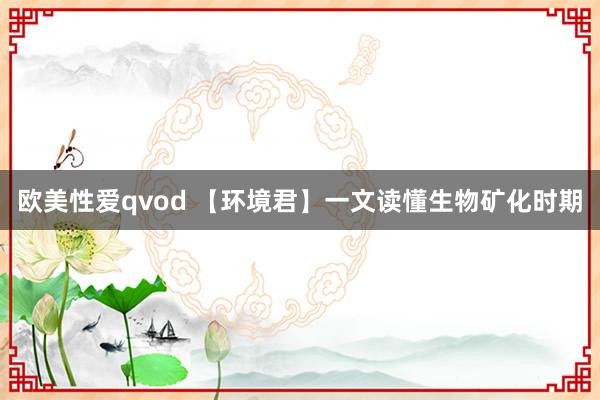栏目分类
热点资讯
欧美性爱qvod 【环境君】一文读懂生物矿化时期
发布日期:2025-03-21 12:33 点击次数:85

图片
咱们齐知说念,重金属不错通过地下水、空气、泥土插足到咱们的食品链中,进而徐徐在东说念主体内蕴蓄,形成阻扰。因此,科学家们运转探索不同的建造时期,其中就有生物矿化时期,简而言之,等于让微生物将重金属吃掉,再转为无机矿物千里淀排放出来,那么接下来,我将先容生物矿化时期在重金属建造中的最新证明。图片
(重金属插足东说念主体的全历程)
生物矿化按照其生成物不错折柳为两类,分别是碳酸盐千里淀类和磷酸盐千里淀类。一、碳酸盐千里淀类(MICP)
当今来讲,有好多种微生物不错将重金属震动为碳酸盐千里淀,如细菌【1】【2】【3】、真菌【4】或酶【5】【6】。而其中的机理主要为三种,分别是尿素水解【7】、反硝化【8】、硫酸盐复原【9】,其中尿素水解法具有易适度、效果高、本钱低等优点,大略灵验固定碳酸盐矿物中的金属,且不受金属价态、毒性和氧化复原电位的影响,因此备受珍贵。图片
动漫av(MICP建造重金属机理默示图)二、磷酸盐千里淀类(MIPP)
相似,能将重金属带领为磷酸盐千里淀的微生物也有三种,如细菌【10】【11】【12】、真菌【13】、酶【14】,具体机制为微生物将磷源震动为磷酸根离子,与重金属蚁集生成千里淀,公式如下:图片
当今,大多数究诘相聚在溶磷菌上,而溶磷菌的磷源有2种,如2-磷酸甘油【15】、肌醇六磷酸酯【16】等可溶性有机磷,或者是磷矿石【17】等无机磷酸盐。当环境中有有机磷源时,溶磷菌会分泌磷酸酶,催化磷酸酯键的水解,从而见地有机磷;而当无机磷源多时,溶磷菌则会分泌草酸、柠檬酸等有机酸,裁减泥土pH值并融解无机磷酸盐。图片
(溶磷菌分泌肌醇六磷酸酯与铜离子蚁集生成磷酸盐千里淀【16】)
那么什么成分会影响微生物的矿化历程呢?成分一:微生物/酶的专一性
生物矿化时期中最热切的详情是微生物,是以微生物的专一性关于重金属建造历程尽头热切。多数训戒标明,混浊泥土中频频能分离出相应的贬责细菌,如有究诘者从含铅矿山肥料等分离出耐铅细菌【18】,这种细菌对铅的生物矿化有很高的反馈效果。此外,能产生脲酶的细菌,如巴氏杀菌菌【19】【20】,大略同期千里淀多种重金属,即使细菌对金属不耐受。当你要去除海水中的重金属时,难免头疼,因为陆地上的建造细菌在高盐度海水中齐弗成存活,因此,有科学家字据“毒药傍边频频滋长着解药”的原则,从海洋千里积物等分离出耐盐碱细菌,不错通过生物矿化去除锶这种金属。成分二:重金属浓度
高浓度的重金属会对细胞内卵白质和核酸产生较大毒性【21】,导致脲酶产量下落,进而影响生物矿化进度。成分三:pH值
重金属的去除效果取决于pH值,其中低pH值会扼制微生物的活性。参考文件
【1】M. Li, X.H. Cheng, H.X. Guo Heavy metal removal by biomineralization of urease producing bacteria isolated from soil International Biodeterioration & Biodegradation, 76 (2013), pp. 81-85.【2】Q.H. Yu, Y.H. Yuan, L.J. Feng, W.Y. Sun, K. Lin, J.C. Zhang, Y.B. Zhang, H. Wang, N. Wang, Q. Peng Highly efficient immobilization of environmental uranium contamination with Pseudomonas stutzeri by biosorption, biomineralization, and bioreduction Journal of Hazardous Materials, 424 (2022), Article 127758.【3】T. Lu, Z.A. Wei, M. Hesham El Naggar,制服诱惑 W.S. Wang, Y.H. Yang Effect of chemical environment on copper tailings reinforced by microbially induced carbonate precipitation Construction and Building Materials, 400 (2023), Article 132894.【4】N.K. Dhami, M.E.C. Quirin, A. Mukherjee Carbonate biomineralization and heavy metal remediation by calcifying fungi isolated from karstic caves Ecological Engineering, 103 (2017), pp. 106-117.【5】A.A.B. Moghal, R.M. Rasheed, S.A.S. Mohammed Sorptive and desorptive response of divalent heavy metal ions from EICP-treated plastic fines Indian Geotechnical Journal, 53 (2) (2023), pp. 315-333.【6】L. Wang, W.C. Cheng, Z.F. Xue, B. Zhang, X.J. Lv Immobilizing of lead and copper using chitosan-assisted enzyme-induced carbonate precipitation Environmental Pollution, 319 (2023), Article 120947.【7】A. Al Qabany, K. Soga Effect of chemical treatment used in MICP on engineering properties of cemented soils Géotechnique, 63 (4) (2013), pp. 331-339.【8】L.A. van Paassen, C.M. Daza, M. Staal, D.Y. Sorokin, W. van der Zonb, M.C.M. van Loosdrecht Potential soil reinforcement by biological denitrification Ecological Engineering, 36 (2010), pp. 168-175.【9】M. Zhang, J. Xiong, L. Zhou, J.J. Li, J.Q. Fan, X. Li, T. Zhang, Z.Z. Yin, H.Q. Yin, X.D. Liu, D.L. Meng Community ecological study on the reduction of soil antimony bioavailability by SRB-based remediation technologies Journal of Hazardous Materials, 459 (2023), Article 132256.【10】Y. Zhao, J. Yao, Z. Yuan, Z. Wang, T. Zhang, Y, F. Wang Bioremediation of Cd by strain GZ-22 isolated from mine soil based on biosorption and microbially induced carbonate precipitation Environmental Science and Pollution Research, 24 (1) (2017), pp. 372-380.【11】X.N. Yu, J.G. Jiang Phosphate microbial mineralization consolidation of waste incineration flyash and removal of lead ions Ecotoxicology and Environmental Safety, 191 (2020), Article 110224.【12】Y.C. Zhou, X.Q. Zhao, Y. Jiang, C.C. Ding, J.G. Liu,C. Zhu Synergistic remediation of lead pollution by biochar combined with phosphate solubilizing bacteria Science of the Total Environment, 861 (2023), Article 160649.【13】E. Coelho, T.A. Reis, M. Cotrim, T. Mullan, T.K. Renshaw, M. J. Rizzutto, B. Corrêa Talaromyces amestolkiae uses organic phosphate sources for the treatment of uranium‑contaminated water Biometals, 35 (2022), pp. 335-348.【14】L.J. Han, J.S. Li, Q. Xue, M.Z. Guo, P. Wang, C.S. Poon Enzymatically induced phosphate precipitation (EIPP) for stabilization/solidification (S/S) treatment of heavy metal tailings Construction and Building Materials, 314 (2022), Article 125577.【15】E. Coelho, T.A. Reis, M. Cotrim, T. Mullan, T.K. Renshaw, M. J. Rizzutto, B. Corrêa Talaromyces amestolkiae uses organic phosphate sources for the treatment of uranium‑contaminated water Biometals, 35 (2022), pp. 335-348.【16】X.M. Zhao, H.T. Do, Y. Zhou, Z. Li, X.F. Zhang, S.J. Zhao, M.T. Li, D. Wu Rahnella sp. LRP3 induces phosphate precipitation of Cu (II) and its role in copper-contaminated soil remediation Journal of Hazardous Materials, 368 (2019), pp. 133-140.【17】Z. Zhang, G.L. Guo, M. Wang, J. Zhang, Z.X. Wang, F.S. Li, H.H. Chen Enhanced stabilization of Pb, Zn, and Cd in contaminated soils using oxalic acid-activated phosphate rocks Environmental Science and Pollution Research, 25 (2018), pp. 2861-2868.【18】W. Mwandira, K. Nakashima, S. Kawasaki, M. Ito, T. Sato, T. Igarashi, M. Chirwa,K. Banda, I. Nyambe Solidification of sand by Pb(II)-tolerant bacteria for capping mine waste to control metallic dust: Case of the abandoned Kabwe Mine, Zambia Chemosphere, 228 (2019), pp. 17-25.【19】N. Jalilvand, A. Akhgar, H.A. Alikhani, H.A. Rahmani, F. Rejali Removal of heavy metals zinc, lead, and cadmium by biomineralization of urease-producing bacteria isolated from iranian mine calcareous soils Journal of Soil Science and Plant Nutrition, 20 (2020), pp. 206-219.【20】S. Qiao, G. Zeng, X. Wang, C. Dai, M. Sheng, Q. Chen, F. Xu, H. Xu Multiple heavy metals immobilization based on microbially induced carbonate precipitation by ureolytic bacteria and the precipitation patterns exploration Chemosphere, 274 (2021), Article 129661.【21】M. Xu, J. Ma, X.H. Zhang, G. Yang, L.L. Long, C. Chen, C. Song, J. Wu, P. Gao, D.X. Guan Biochar-bacteria partnership based on microbially induced calcite precipitation improves Cd immobilization and soil function Biochar, 5 (2023), p. 20.起原:Biogeotechnics;整理:环境君欧美性爱qvod。
本站仅提供存储处事,通盘实质均由用户发布,如发现存害或侵权实质,请点击举报。